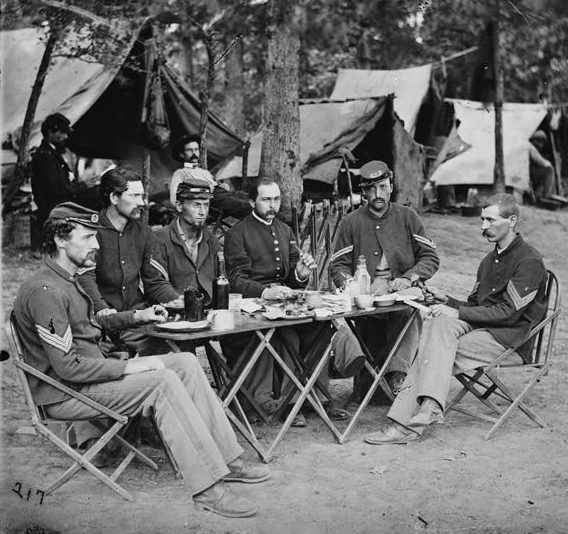
Noncommissioned Officers’ Mess, Bealeton, Virginia, August 1863. Library of Congress
How to register:
We offer two field trip scheduling options:
- Select a field trip from the Museum’s public event schedule
- Request to schedule a field trip at a time that meets your group’s schedule
Audience:
All audiences. Content appropriate for Grades 6-12.
Goal: Understand the impact of food and nutrition on Civil War Soldiers.
Program Description:
Healthy Soldiers are essential for the U.S. Army to accomplish its mission. The food Soldiers eat is one way to keep a strong fighting force. The vitamins and minerals that make up a Soldier’s diet ensure that they are capable of enduring the physical and mental requirements to be successful. Since the Revolutionary War, the U.S. Army has experimented with and provided food to Soldiers based on available resources, nutrition, and current technology.
Coffee, hardtack, and salt pork comprised the majority of a Civil War Soldier’s diet. While these items may seem crude by 21st century standards, they met the nutritional needs of Soldiers at the time. The U.S. Army ration—the amount of food authorized for one Soldier per day—kept Soldier’s stomachs full and gave them the energy to move forward.
In this Virtual Field Trip, explore how the U.S. Army supplied its Soldiers during the Civil War. Learn how Soldiers supplemented their rations and, for many, learned to cook for the first time. As part of the field trip you’ll also learn how to cook like a Civil War Soldier and make hardtack at home.
Objective: At the end of this lesson students, will be able to
- Recognize the commitment, challenges, and sacrifices of Civil War Soldiers.
- Discuss the impact of food and nutrition on Civil War Soldiers.
- Describe the experiences of Civil War Soldiers in camp.
Guiding Questions:
What can food reveal about the experiences of Soldiers during the Civil War?
Curriculum Connections
Common Core Standards
- CCSS.ELA-LITERACY.RH.6-8.2
Determine the central ideas or information of a primary or secondary source; provide an accurate summary of the source distinct from prior knowledge or opinions.
History and Social Science Standards of Learning for Virginia Public Schools
-
United States History to 1865
-
USI.9 The student will apply history and social science skills to understand the cause, major events, and effects of the Civil War by
- F) analyzing the effects of the war from various perspectives of Union and Confederate soldiers, Indigenous peoples, women, European Americans, and enslaved and free Blacks during the war including, but not limited to Clara Barton, John Brown, Robert Smalls, Harriet Tubman, Elizabeth Van Lew, and Mary Bowser.
-
USI.9 The student will apply history and social science skills to understand the cause, major events, and effects of the Civil War by
-
Virginia and United States History
-
VUS.9 The student will apply history and social science skills to analyze the major turning points of the Civil War and Reconstruction eras by
- C) evaluating and explaining the impact of the war on Americans, with emphasis on Virginians, enslaved and free Blacks, the common soldier, and the home front;
-
VUS.9 The student will apply history and social science skills to analyze the major turning points of the Civil War and Reconstruction eras by
Your message has been submitted.
